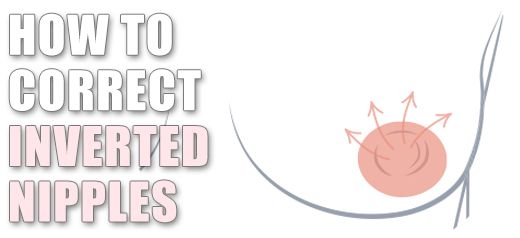How to correct inverted nipples and what are the causes?

No two breasts are the same; this is something that most women know all too well, and in some cases, rather than pointing outwards the nipple can be flat or inverted. It’s thought that between 10% and 20% of women have suffered from some degree of nipple inversion at some point in their lives.
Inverted nipples are nothing to worry about and needn’t be a cause for concern because, if it’s something you’re really unhappy about, it’s something that can be fixed with relative ease by employing inverted nipple correction surgery.
A lot of women feel uneasy about inverted nipples because it remains very much a taboo subject, as in it’s not really something that people talk openly about, but it’s something that’s completely normal. Nipple inversion is rated on a scale of severity – it doesn’t matter whether it’s just a shy nipple, or one that’s completely inverted, the scale will depend on the state of the nipple as causes of each will vary greatly.
Before delving into each grade individually we’ll take a look at the most general causes of inverted nipples:
Congenital – this means you’ve been born with them
Surgery – scar tissue, caused by surgery on or around the breast, can cause inversion
Breastfeeding – can cause damage to milk ducts, causing them to retract and pull the nipple inwards
Breast drooping – as you get older, skin loses elasticity and as a result, the skin around the nipple becomes looser
Infection – infections can cause inflammation resulting in scar tissue which will pull the nipple inside
Pregnancy
Breast cancer
The Inverted Nipple Scale:
Grade 1 inverted nipples
Grade 1 inverted nipples are usually referred to as shy nipples that can be coaxed out to protrude, just like a normal nipple. This is usually achieved by massaging the nipple, or exposing it to the cold. The cause of shy nipples is not obvious and cannot be attributed to breastfeeding as the milk ducts are not affected and there’s rarely any evidence of fibrosis.
Grade 2 inverted nipples
Grade 2 inverted nipples can also be coaxed out. However, it’s not as easy and, often, as soon as pressure is once again released, the nipple slips back into its inverted state. This type of inversion is usually caused by fibrosis and a slight retraction of the milk ducts. Both of these things result in the nipple constantly being pulled inwards by the breast fibres, resulting in an inversion.
Grade 3 inverted nipples
Grade 3 inverted nipples are truly inverted. They are permanently pulled in and will never be seen to protrude. Correcting this kind of inversion almost always requires surgery to correct the nipple. The surgery is popular with women still to have children and hoping to breastfeed. Full inversion of the nipple can make breast feeding extremely difficult and, in a lot of cases, can even prevent the ability to breastfeed altogether.
The cause of a full inversion is short milk ducts and extreme fibrosis; this effectively causes the nipple to be dragged inwards and attached to tissue within the breast, which makes the chance of nipple protrusion virtually impossible.
Cosmetic Surgery Partners expertise
Our consultant surgeons are specialists in cosmetic surgery, particularly breast surgery procedures, and operate from a leading, easy to access, central London located venue in the Harley Street area.
With Cosmetic Surgery Partners, you are assured quality consultation, surgery and aftercare. We have some of the best surgeons in the industry and having famously introduced the, now widely used, ABBA breast lifting technique.
If you’re considering nipple correction surgery, get in touch with one of our expert team today and find out how we can help. Visit our contact page or give us a call on, 020 7486 6778.





